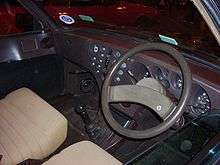Dashboard
A dashboard (also called dash, instrument panel (IP), or fascia) is a control panel located directly ahead of a vehicle's driver, displaying instrumentation and controls for the vehicle's operation.
Etymology
.png)
Originally, the word dashboard applied to a barrier of wood or leather fixed at the front of a horse-drawn carriage or sleigh to protect the driver from mud or other debris "dashed up" (thrown up) by the horses' hooves.[1] Commonly these boards did not perform any additional function other than providing a convenient handhold for ascending into the driver's seat, or a small clip with which to secure the reins when not in use.
When the first "horseless carriages" were constructed in the late 19th century, with engines mounted beneath the driver such as the Daimler Stahlradwagen, the simple dashboard was retained to protect occupants from debris thrown up by the cars' front wheels. However, as car design evolved to position the motor in front of the driver, the dashboard became a panel that protected vehicle occupants from the heat and oil of the engine. With gradually increasing mechanical complexity, this panel formed a convenient location for the placement of gauges and minor controls, and from this evolved the modern instrument panel, although retaining its archaic common name.
Modern dashboard items

Items located on the dashboard at first included the steering wheel and simple instrumentation to show speed, fuel level and oil pressure. However, the instrument cluster of a modern car or motorcycle may be far more complex and in addition to basics information provided by the speedometer, tachometer, odometer and fuel gauge, may feature gauges and tell-tales such as turn indicators, gearshift position, seat belt warning light, parking-brake-engagement warning light[2] and an engine-malfunction light. There may also be indicators for low fuel, low oil pressure, low tire pressure and faults in the airbag (SRS) system. Heating and ventilation controls and vents, lighting controls, audio equipment and automotive navigation systems are also mounted on the dashboard.
The top of a dashboard may contain vents for the heating and air conditioning system and speakers for an audio system. A glove compartment is commonly located on the passenger's side. There may also be an ashtray and a cigarette lighter which can provide a power outlet for other low-voltage appliances.
Padding and safety
In 1937, Chrysler, Dodge, DeSoto, and Plymouth cars came with a safety dashboard that was flat, raised above knee height, and had all the controls mounted flush.[3]
Padded dashboards were advocated in the 1930s by car safety pioneer Claire L. Straith.[4] In 1948, the Tucker became the first car with a padded dashboard.[5]
One of the safety enhancements of the 1970s was the widespread adoption of padded dashboards. The padding is commonly polyurethane foam, while the surface is commonly either polyvinyl chloride (PVC) or leather in the case of luxury models.
In the early and mid-1990s, airbags became a standard feature of steering wheels and dashboards.
Fashion in instrumentation

In the 1940s through the 1960s, American car manufacturers and their imitators designed unusually-shaped instruments on a dashboard laden with chrome and transparent plastic, which could be less readable, but was often thought to be more stylish. Sunlight could cause a bright glare on the chrome, particularly for a convertible.
With the coming of the LED in consumer electronics, some manufacturers used instruments with digital readouts to make their cars appear more up to date, but this has faded from practice. Some cars use a head-up display to project the speed of the car onto the windscreen in imitation of fighter aircraft, but in a far less complex display.
In recent years, spurred on by the growing aftermarket use of dash kits, many automakers have taken the initiative to add more stylistic elements to their dashboards. One prominent example of this is the Chevrolet Sonic which offers both exterior (e.g., a custom graphics package) and interior cosmetic upgrades.[6] In addition to OEM dashboard trim and upgrades a number of companies offer domed polyurethane or vinyl applique dash trim accent kits or "dash kits."
Manufacturers such as BMW, Honda, Toyota and Mercedes-Benz have included fuel-economy gauges in some instrument clusters, showing fuel mileage in real time. The ammeter was the gauge of choice for monitoring the state of the charging system until the 1970s. Later it was replaced by the voltmeter. Today most family vehicles have warning lights instead of voltmeters or oil pressure gauges in their dashboard instrument clusters, though sports cars often have proper gauges for performance purposes and driver appeasement.
See also
References
| Wikimedia Commons has media related to Dashboards. |
| Look up dash in Wiktionary, the free dictionary. |
- ↑ "Dictionary entry for dashboard". Merriam–Webster. Retrieved 2006-10-11.
- ↑
- Signal to Warn Driver that the Emergency Brake is Engaged, Popular Science monthly, February 1919, Unlabeled page, Scanned by Google Books: https://books.google.com/books?id=7igDAAAAMBAJ&pg=PT3
- ↑ http://www.oldcarbrochures.com/static/NA/Chrysler_and_Imperial/1937_Chrysler/1937_Chrysler_Royal-Imperial_Brochure/1937%20Chrysler%20Royal%20%20amp%20%20Imperial-31.html
- ↑ Straith Clinic History
- ↑ http://www.oldcarbrochures.com/static/NA/Tucker/album/album/1948%20Tucker-04.html
- ↑ http://www.chevrolet.com/sonic-small-car/accessories.html